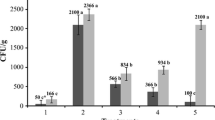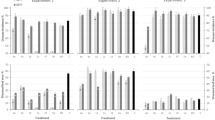Abstract
Black rot of Brassica spp. caused by the bacterial pathogen Xanthomonas campestris pv. campestris (XCC), is a seedborne disease. Because the pathogen can easily be spread by splashing water, there is a high risk of spreading it by overhead irrigation systems during the raising of cabbage transplants. In glasshouse experiments, the efficacy of different methods to reduce XCC dispersal and subsequent black rot development during the raising of transplants were examined. The three methods tested were 1) chlorine dioxide dosing of overhead irrigation water, 2) spray treatments of transplants with commercially available products that contain disinfectant or have bactericidal properties (benzoic acid and copper hydroxide) and 3) an ebb and flood irrigation system. Trays with inoculated cauliflower transplants that had been raised from modules were placed between trays with healthy transplants. XCC transmission from the spray inoculated infector to non-inoculated transplants was detected using PCR after four days. The mean efficiency of 1–2 sprayings with benzoic acid and copper hydroxide in reducing black rot development was 11.6% and 32.2%, respectively. Overhead irrigation with chlorine dioxide enriched water resulted in a mean efficiency of 93.5%. No symptoms of black rot were observed in the ebb and flow irrigation system. The proportion of symptomless, XCC-DNA positive transplants at the end of the incubation period followed the same pattern as the visual black rot development. To obtain a minimum concentration of 0.21 mg l−1 chlorine dioxide effective against XCC, a feed-in concentration of 3 mg l−1 was used, resulting in a final concentration of 0.5 to 1.0 mg l−1 wetting the leaf surface. The positive effects of both “sub-” and “chlorine dioxide dosed” irrigation to reduce the spread of XCC during transplant raising were still apparent in the field and resulted in a healthier crop.
Similar content being viewed by others
References
Anonymus, 1988., Richtlinien für die Prüfung von Desinfektionsmitteln, 2nd ed., Giessen.
Anonymus, 2008. Statistisches Bundesamt Deutschland, Landwirtschaftliche Bodennutzung — Gemüseanbauflächen — FacDeutsche Veterinärmedizinische Gesellschafthserie 3, Reihe 3.1.3, p. 18.
Berg T, Tesoriero L & Hailstones DL, 2005. PCR-based detection of Xanthomonas campestris pathovars in brassica seed. Plant Pathol 54, 416–427.
Block SS, 2001. Disinfection, Sterilization, and Preservation. 5th ed., Lippingcott, Williams and Wilkins, Philadelphia.
Copes WE, Chastaganer GA & Hummel RL, 2004. Activity of chlorine dioxide in a solution of ions and pH against Thielaviopsis basicola and Fusarium oxysporum. Plant Dis 88, 188–194.
Elphinstone J & Harris A, 2002. Monitoring and control of the potato brown rot bacterium in irrigation water. British Potato Council, Oxford, UK.
Grimm R & Vogelsanger J, 1990. Black rot disease on cabbage, irrigation and spreading. Proc. of the 7th Int. Conference on Plant Pathogenic Bacteria, Budapest, Hungary, June 11–16, 1989, 225–229.
Krauthausen HJ, Kreiselmaier J, Laun N & Schlaghecken J, 2006. Xanthomonas-Adernschwärze des Kohls. Gemüse 42, 24–26.
Pao S, Kelsey DF, Khalid MF & Ettinger MR, 2007. Using aqueous chlorine dioxide to prevent contamination of tomatoes with Salmonella enterica and Erwinia carotovora during fruit washing. J Food Protect 70, 629–634.
Roberts RG & Reymond ST, 1994. Chlorine dioxide for reduction of postharvest pathogen inoculum during handling of tree fruits. Appl Environ Microbiol 60, 2864–2868.
Roberts SJ, Hiltunen LH, Hunter PJ & Brough J, 1999. Transmission from seed to seedling and secondary spread of Xanthomonas campestris pv. campestris in brassica transplants: effects of dose and watering regime. Eur J Plant Pathol 105, 879–889.
Roberts SJ, Brough J & Hunter PJ, 2007. Modelling the spread of Xanthomonas campestris pv. campestris in module-raised brassica transplants. Plant Pathol 56, 391–401.
Shigaki T, Nelson SC & Alvarez AM, 2000. Symptomless spread of blight inducing strains of Xanthomonas campestris pv. campestris on cabbage seedlings in misted seedbeds. Eur J Plant Pathol 106, 339–346.
Schaad NW, Jones JB & Chun W, 2001. Laboratory guide for identification of plant pathogenic bacteria, 3rd ed., APS Press, St. Paul, MN, USA.
Schlaghecken J & Kreiselmaier J, 2002. Blumenkohl — Von Anbau bis Verzehr. CD-ROM, DLR Rheinpfalz, Neustadt/ Weinstraβe, Germany.
Williams PH, 1980. Black rot: a continuing threat to world crucifers. Plant Dis 64, 736–742.
Williams PH, 2007. Black rot. In: Rimmer RS, Shattuk VI & Buchwaldt L (Eds.) 2007: Compendium of Brassica Diseases, APS Press, St. Paul, MN, USA, 60–62.
Wilson EE, Zeitoun FM & Fredrickson DL, 1967. Bacterial phloem canker, a new disease of Persian walnut trees. Phytopathology 57, 618–621.
Wohanka W, Molitor HD & Weichlein D, 2005. Verhinderung der Krankheitsausbreitung bei Ebbe/Flutbewässerung mittels Wasserdesinfektion durch Chlordioxid. Bericht über die wissenschaftliche Betreuung des Forschungs- und Entwicklungsvorhabens im Agrarbereich für Umweltschutz (03UM002). http://download.ble.de/03UM002_W.pdf.
Wu DX, Yang C, Li F, Hu XQ, Wang YL, Reng GM, Zhu HJ & Lu J, 2006. Sterilization of leaf-cutting tools in tobacco floating seedling system using chlorine dioxide. J. Yunnan Agricultural University 21, 188–191 (Abstract).
Zaccardelli M, Campanile F, Moretti C & Buonaurio R, 2008. Characterization of Italian populations of Xanthomonas campestris pv. campestris using primers based on DNA repetitive sequences. J Plant Pathol 90, 375–381.
Author information
Authors and Affiliations
Corresponding author
Rights and permissions
About this article
Cite this article
Krauthausen, HJ., Laun, N. & Wohanka, W. Methods to reduce the spread of the black rot pathogen, Xanthomonas campestris pv. campestris, in brassica transplants. J Plant Dis Prot 118, 7–16 (2011). https://doi.org/10.1007/BF03356375
Received:
Accepted:
Published:
Issue Date:
DOI: https://doi.org/10.1007/BF03356375




